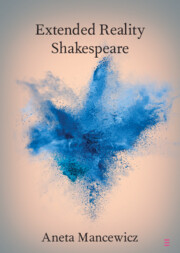References
Abel, Lionel. (1963). Metatheatre: A New View of Dramatic Form. New York: Hill and Wang.
Allred, Gemma Kate, Broadribb, Benjamin, and Sullivan, Erin, eds. (2022). Lockdown Shakespeare: New Evolutions in Performance and Adaptation. The Arden Shakespeare. London: Bloomsbury. https://doi.org/10.5040/9781350247833. Anonymous. (2021). ‘Current, Rising – Royal Opera House, London (LAST CHANCE TO SEE)’. Salterton Arts Review. London Arts, Theatre and Heritage Reviews and Recommendations. 6 June. https://bit.ly/3tXqCt4. Barba, Evan, MacIntyre, Blair, and Mynatt, Elizabeth D.. (2012). ‘Here We Are! Where Are We? Locating Mixed Reality in the Age of the Smartphone’. Proceedings of the IEEE, 100(4): 929–36.
Bay-Cheng, Sarah. (2015). ‘Taxonomy of Distortion. Along the Media Performance Continuum’. In Performance and Media: Taxonomies for a Changing Field, edited by Bay-Cheng, Sarah, Starbuck, Jennifer Parker, and Saltz, David Z., 39–64. Ann Arbor: University of Michigan Press. https://doi.org/10.3998/mpub.5582757. Sarah, Bay-Cheng, Parker-Starbuck, Jennifer, and Saltz, David Z.. (2015). Performance and Media: Taxonomies for a Changing Field. Ann Arbor: University of Michigan Press. https://doi.org/10.3998/mpub.5582757. Benford, Steve, and Giannachi, Gabriella. (2011). Performing Mixed Reality. Cambridge, MA: MIT Press.
Jay David, Bolter, and Grusin, Richard. (2000). Remediation: Understanding New Media. Cambridge, MA: MIT Press.
Bowers, Fredson. (1940). Elizabethan Revenge Tragedy 1587–1642. Princeton, NJ: Princeton University Press.
Broadribb, Benjamin. (2021). ‘Review of Pippa Hill’s Dream (Directed by Robin McNicholas for the Royal Shakespeare Company) at Portsmouth Guildhall. Performed and Streamed Online, 12–20 March 2021’. Shakespeare, 17(4): 492–5. https://doi.org/10.1080/17450918.2021.1950204. Bushnell, Rebecca W., and Ullyot, Michael. (2022). ‘Shakespeare and Virtual Reality’. In The Routledge Handbook of Shakespeare and Interface, edited by Werier, Clifford and Budra, Paul, 29–43. New York: Routledge. https://doi.org/10.4324/9780367821722-4. Clapp, Susannah. (2021). ‘Dream Review – The RSC’s Hi-tech Shakespeare Only Goes So Far’. Guardian. 21 March. https://bit.ly/3u3fyuF. Coghlan, Alexandra. (2021). ‘Current, Rising, Royal Opera House Review – A Joyful Celebration of Storytelling Possibility’. Arts Desk. 21 May. https://bit.ly/49D3G2X. Çöltekin, Arzu, Lochhead, Ian, Madden, Marguerite, et al. (2020). ‘Extended Reality in Spatial Sciences: A Review of Research Challenges and Future Directions’. ISPRS International Journal of Geo-Information, 9(439): 1–29. https://doi.org/10.3390/ijgi9070439. Crouch, Tim. (2022). Truth’s a Dog Must to Kennel. London: Methuen Drama.
Dalton, Jeremy. (2021). Reality Check: How Immersive Technologies Can Transform Your Business. London: Kogan Page.
Embley, Jochan. (2021). ‘Current, Rising at the Royal Opera House Review: A Terrifically Trippy Opera Experience’. Evening Standard. 19 May. https://bit.ly/3FPuoaA. Falk, Dan. (2014). The Science of Shakespeare: A New Look at the Playwright’s Universe. New York: Thomas Dunne Books.
Fischer-Lichte, Erika. (2008). The Transformative Power of Performance: A New Aesthetics. Translated by Saskya Iris Jain. London: Routledge.
Georgi, Claudia. (2014) Liveness on Stage: Intermedial Challenges in Contemporary British Theatre and Performance. Berlin: Walter de Gruyter.
Hewett, Ivan. (2021). ‘Current, Rising, Royal Opera House, Review: “Virtual Reality” Is No Match for Serious Opera’. The Telegraph. 21 May. https://bit.ly/47l6uj7. Holz, Thomas, Campbell, Abraham G., Gregory, M. P. O’Hare, John W. Stafford, Martin, Alan, and Dragone, Mauro. (2011). ‘MiRA – Mixed Reality Agents’. International Journal of Human–Computer Studies, 69(4): 251–68. https://doi:10.1016/j.ijhcs.2010.10.001. Jenkins, Henry. (2006). Convergence Culture: Where Old and New Media Collide. New York: New York University Press.
Kattenbelt, Chiel. (2006). ‘Theatre as the Art of the Performer and the Stage of Intermediality’. In Intermediality in Theatre and Performance, edited by Chapple, Freda and Kattenbelt, Chiel, 29–39. Amsterdam: Rodopi. https://doi.org/10.1163/9789401210089. Kattenbelt, Chiel. (2008). ‘Intermediality in Theatre and Performance: Definitions, Perceptions and Medial Relationships’. Cultura, Lenguaje y Representación [Culture, Language & Representation], 6 (La Intermedialidad [Intermediality]): 19–29.
Kattenbelt, Chiel. (2010). ‘Intermediality in Performance and as a Mode of Performativity’. In Mapping Intermediality in Performance, edited by Bay-Cheng, Sarah, Kattenbelt, Chiel, Lavender, Andy, and Nelson, Robin, 29–37. Amsterdam: Amsterdam University Press. https://doi.org/10.5117/9789089642554. Kattenbelt, Chiel. (2021). ‘On Artistic Research, Intermediality and the “Hamlet Encounters” Project’. In Performing/Transforming: Transgressions and Hybridizations Across Texts, Media, Bodies, edited by Puglisi, Floriana, 17–37. Torino: Otto.
Nick., Kaye (2000). Site-Specific Art: Performance, Place and Documentation. London: Routledge.
Kirwan, Peter. (2021). ‘Dream Online (Royal Shakespeare Company) @ online’. University of Nottingham Blog Post. 20 March.https://bit.ly/3FNER6x. Kott, Jan. (1967). Shakespeare Our Contemporary. Translated by Bolesław Taborski. London: Methuen.
Lamb, Hilary. (2021). ‘Theatre Review: “Dream”, the Royal Shakespeare Company’. Engineering and Technology. 17 March. https://bit.ly/3Qr5zqy. Lewis, C. S. (1964). Discarded Image: An Introduction to Medieval and Renaissance Literature. Cambridge: Cambridge University Press.
MacIntyre, Blair, Gandy, Maribeth, Dow, Steven, and David Bolter, Jay. (2004). ‘DART: A Toolkit for Rapid Design Exploration of Augmented Reality Experiences’. In Proceedings of the 17th Annual ACM Symposium on User Interface Software and Technology (UIST ’04). ACM, New York, 197–206. https://doi.org/10.1145/1029632.1029669. Mancewicz, Aneta. (2023). ‘Liveness in VR and AR Shakespeare Adaptations’. In Early Modern Liveness: Mediating Presence in Text, Stage and Screen, edited by Rosvally, Danielle and Sherman, Donovan, 89–110. The Arden Shakespeare. London: Bloomsbury. https://doi.org/10.5040/9781350318502.0012. McLuhan, Marshall. (1964 [2001]). Understanding Media: The Extensions of Man. London: Routledge.
Milgram, Paul, and Kishino, Fumio. (1994). ‘A Taxonomy of Mixed Reality Visual Displays’. IEICE Transactions on Information Systems, E77-D(12): 1321–9.
Milgram, Paul, Takemura, Haruo, Utsumi, Akira, and Kishino, Fumio. (1994). ‘Augmented Reality: A Class of Displays on the Reality–Virtuality Continuum’. Proceedings of SPIE – The International Society for Optical Engineering, 2351, Telemanipulator and Telepresence Technologies: 282–92. https://doi.org/10.1117/12.197321. Müller, Jürgen E. (2010). ‘Intermediality and Media Historiography in the Digital Era’. Acta Universitatis Sapientiae, Film, and Media Studies, 2: 15–38.
Nedelkopoulou, Eirini, Joris, Eric, Bekaert, Philippe, and Vanhoutte, Kurt. (2014). ‘On the Border Between Performance, Science and the Digital: A Conversation with CREW’. International Journal of Performance Arts and Digital Media, 10(2): 246–54. https://doi.org/10.1080/14794713.2014.946290. Nelson, Robin. (2010). ‘Experiencer’. In Mapping Intermediality in Performance, edited by Bay-Cheng, Sarah, Kattenbelt, Chiel, Lavender, Andy, and Nelson, Robin, 45. Amsterdam: Amsterdam University Press. https://doi.org/10.5117/9789089642554. Oliver, Ben. (2020). ‘The Royal Opera House Presents Current, Rising, the World’s First Opera in Hyper Reality’. Royal Opera House News. 23 November. https://bit.ly/3SQR7uX. Ormerod, Peter. (2021). ‘REVIEW: RSC’s Experimental Dream Gives an Intriguing Glimpse into the Future of Live Entertainment’. Northampton Chronicle & Echo. 17 March. https://bit.ly/3MBWXfo. Pluta, Izabella. (2010). ‘Hybridity’. In Mapping Intermediality in Performance, edited by Bay-Cheng, Sarah, Kattenbelt, Chiel, Lavender, Andy, and Nelson, Robin, 186–7. Amsterdam: Amsterdam University Press. https://doi.org/10.5117/9789089642554. Postlewait, Thomas, and Davis, Tracy C.. (2003). ‘Theatricality: An Introduction’. In Theatricality, edited by Davis, Tracy C. and Postlewait, Thomas, 1–39. Cambridge: Cambridge University Press.
Aswin, Punathambekar, and Mohan, Sriram. (2019). ‘Introduction: Mapping Global Digital Cultures’. In Global Digital Cultures: Perspectives from South Asia, edited by Punathambekar, Aswin and Mohan, Sriram. Ann Arbor: University of Michigan Press. https://doi.org/10.3998/mpub.9561751. Rauschnabel, Philipp A., Felix, Reto, Hinsch, Chris, Shahab, Hamza, and Alt, Florian. (2022). ‘What Is XR? Towards a Framework for Augmented and Virtual Reality’. Computers in Human Behavior 133, article 107289: 1–18. https://doi.org/10.1016/j.chb.2022.107289. Roberts-Smith, Jennifer. (2022). ‘What Can Shakespeare Do for Virtual Reality?’. In Shakespeare and Virtual Reality, edited by Wittek, Stephen and McInnis, David, 4–11. Cambridge: Cambridge University Press. https://doi.org/10.1017/9781009003995. Rouse, Rebecca, Engberg, Maria, JafariNaimi, Nassim, and David Bolter, Jay. (2015). ‘MRx: An Interdisciplinary Framework for Mixed Reality Experience Design and Criticism’. Digital Creativity, 26(3–4): 175–81. https://doi.org/10.1080/14626268.2015.1100123. Sauter, Willmar. (2000). The Theatrical Event: Dynamics of Performance and Perception. Iowa City: University of Iowa Press.
Schmitt, Carl. (2006). Hamlet or Hecuba: The Irruption of Time into Play. Translated by Simona Draghici. Corvallis, OR: Plutarch Press.
Sen, Amrita, ed. (2022). ‘Introduction: Experiencing Digital Shakespeares in the Global South’. In Digital Shakespeares from the Global South, edited by Sen, Amrita. Cham: Palgrave Macmillan. https://doi.org/10.1007/978-3-031-04787-9. Shakespeare, William. (1999). The Tempest. Edited by Vaughan, Virginia Mason and Vaughan, Alden T.. The Arden Shakespeare. London: Thomson Learning.
Shakespeare, William. (2007). Hamlet. Edited by Thompson, Ann and Taylor, Neil. The Arden Shakespeare. London: Thomson Learning.
Shakespeare, William. (2017). A Midsummer Night’s Dream. Edited by Chaudhuri, Sukanta. The Arden Shakespeare. London: Bloomsbury.
Soloski, Alexis. (2021). ‘Review: Living the “Dream,” on Your Laptop or Phone.’ New York Times. 17 March.https://bit.ly/47546NK. Speicher, Maximilian, Hall, Brian D., and Nebeling, Michael. (2019). ‘What Is Mixed Reality?’. In CHI Conference on Human Factors in Computing Systems Proceedings (CHI 2019), 4–9 May, Glasgow, Scotland, UK, ACM, New York, USA. https://doi.org/10.1145/3290605. Sutherland, Gill. (2021). ‘Interview: EM Williams on Playing Puck in New Digital Dream Now on at the RSC’. Stratford-upon-Avon Herald. 13 March.https://bit.ly/3sxqAaX. Vanhoutte, Kurt, and Bigg, Charlotte. (2014). ‘On the Border Between Performance, Science and the Digital: The Embodied Orrery’. International Journal of Performance Arts and Digital Media, 10(2): 255–60. https://doi.org/10.1080/14794713.2014.946291. Weijdom, Joris. (2017). Mixed Reality and the Theatre of the Future: Fresh Perspectives on Arts and New Technologies. Brussels: IETM. www.ietm.org. Wolf, Matt. (2022). ‘RSC “Dream” Is an Inventive, Condensed Take on the Bard’. London Theatre. 25 January. https://bit.ly/3QQcb37. Nele, Wynants, Vanhoutte, Kurt, and Bekaert, Philippe. (2008). ‘Being Inside the Image – Heightening the Sense of Presence in a Video Captured Environment through Artistic Means: The Case of CREW’. In PRESENCE 2008, Proceedings of the 11th Annual International Workshop on Presence. Padova, 16–18 October. Edited by Spagnolli, Anna and Gamberini, Luciano, 157–62. Padova: CLEUP.



